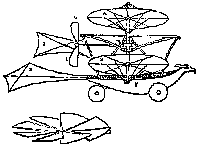




 RB50 Trent
RB50 Trent GE/NASA UDF
GE/NASA UDF
Timetable: Development of the Propeller |
| 400 BC | Archytas, disciple of Pythagoras, puts an inclined plane on a cylinder. | |
| 220 BC | Archimedes uses screws to lift water. | |
| 1480-1510 |  |
Leonardo da Vinci sketches a helicopter, using a screw, as well as an rotating spit, driven by a screw. |
| 1680 | Robert Hooke notes that vanes of a windmill could be used to move water. | |
| 1752 | Bernoulli suggests propelling boats using «vanes set at an angle of 60º to both the arbor and the keel». | |
| 1770 | James Watt proposes a screw propeller, though opposed to use his steam engines on board ships. | |
| 1776 | David Bushnell uses a propeller to drive his submarine Turtle. In contrast to the illustration showing a screw, the propeller was made of single blades. |
|
| 1784 | The Frenchman Vallet propels a boat with a propeller mounted above the boat, in the following year he uses a three bladed propeller mounted below a balloon. | |
| 1786 | A.J.P. Paucton publishes his «Théorie de la vis d´Archimède» and proposes a horizontal axis rotor for propulsion. | |
| 1798 | Robert Fulton experiments with a four bladed propeller on a ship. | |
| 1800 | Edward Shorter patents the «perpetual sculling machine». Two years later, HMS Dragon, powered by 8 men at a capstan, achieves 1.5 knots. | |
| 1829 | The Morgan wheel is patented, using Hooke's windmill idea, with feathering vanes. | |
| 1815 | Richard Trevithick designs a propeller with blades placed obliquely on a cylinder, powered by a steam engine. | |
| 1816-1846 |  |
Patents for propellers are granted at least to John Millington, Charles Cummerow, Julius Pumphrey , Bennet Woodcroft, Francis Pettit Smith, John Ericsson, James Lowe, George Blaxland. All these patents are for marine usage and lead to several lawsuits in England. |
| 1843 | Sir George Cayley designs an ingenious convertiplan, equipped with four rotors and twin propellers. |  |
| 1865 | Rankine develops his momentum theory. | |
| 1878 |  |
William Froude develops the blade element theory. |
| 1900-1905 | The Wright brothers design and test propellers systematically and succeed in 1903, performing their famous first powered flights. | |
| 1907 | Lancaster publishes his «Aerodynamics», including a theory of optimum propellers. | |
| 1910 | Coanda tests his piston engine powered jet unit. | |
| 1919 | Ludwig Prandtl and Albert Betz calculate optimum propellers, having minimum induced loss. | |
| 1919 | Fixed pitch propellers with metal blades enter service. | |
| 1924 | The constant speed propeller is patented by Dr. H. S. Hele-Shaw and T. E. Beacham. | |
| 1932 | Variable pitch propellers are introduced into air force service. | |
| 1935 | Constant speed propellers become available. | |
| 1939 | The Heinkel He 178 makes the first flight of a turbo jet driven airplane. | |
| 1945 | The first turboprop engines are tested by Rolls-Royce on a Gloster Meteor. |  RB50 Trent
RB50 Trent |
| 1980s |  GE/NASA UDF
GE/NASA UDF |
NASA and industry perform tests with high speed propellers (propfans and unducted fans) for transport aircraft. |
| 2002 | You read this table about propellers and ... nothing happens. | |
Last modification of this page: 21.05.18
![]()
[Back to Home Page] Suggestions? Corrections? Remarks? e-mail: Martin Hepperle.
Due to the increasing amount of SPAM mail, I have to change this e-Mail address regularly. You will always find the latest version in the footer of all my pages.
It might take some time until you receive an answer
and in some cases you may even receive no answer at all. I apologize for this, but
my spare time is limited. If you have not lost patience, you might want to send
me a copy of your e-mail after a month or so.
This is a privately owned, non-profit page of purely educational purpose.
Any statements may be incorrect and unsuitable for practical usage. I cannot take
any responsibility for actions you perform based on data, assumptions, calculations
etc. taken from this web page.
© 1996-2018 Martin Hepperle
You may use the data given in this document for your personal use. If you use this
document for a publication, you have to cite the source. A publication of a recompilation
of the given material is not allowed, if the resulting product is sold for more
than the production costs.
This document may accidentally refer to trade names and trademarks, which are owned by national or international companies, but which are unknown by me. Their rights are fully recognized and these companies are kindly asked to inform me if they do not wish their names to be used at all or to be used in a different way.
This document is part of a frame set and can be found by navigating from the entry point at the Web site http://www.MH-AeroTools.de/.